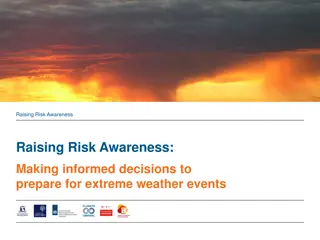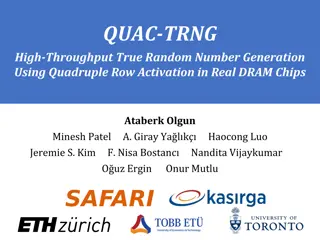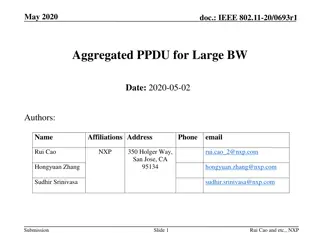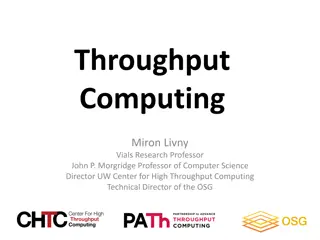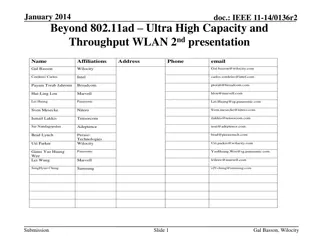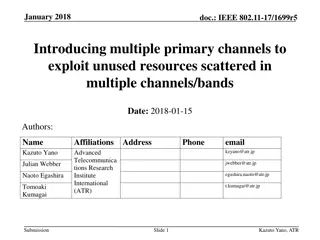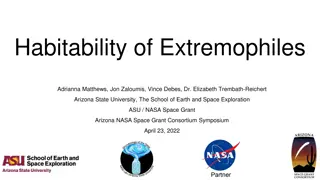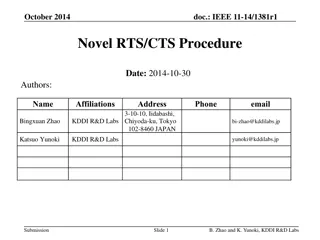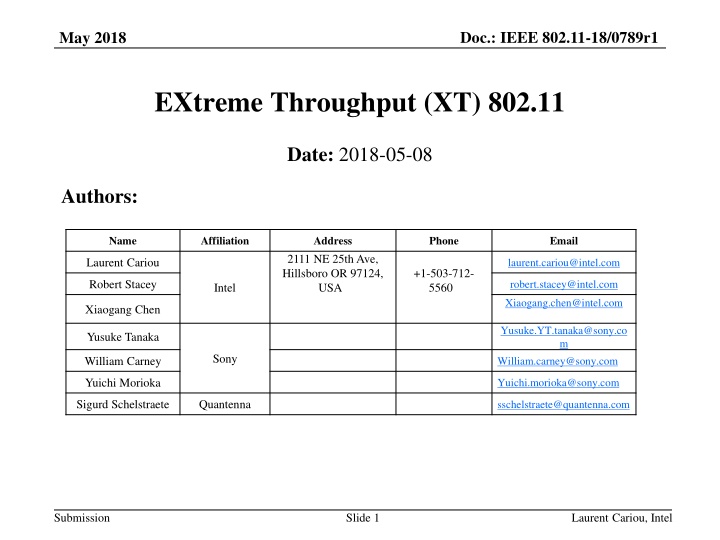
Next Generation Wi-Fi Objectives and Spectrum Expansion
"Explore the proposal for a new Wi-Fi study group targeting extreme throughput, peak capacity increase, and utilization of unlicensed spectrum at 6GHz. Find out the prioritized technical solutions and objectives set for the upcoming Wi-Fi generation. Discover the potential of tri-band devices and multi-band spectrum utilization for enhanced performance."
Download Presentation

Please find below an Image/Link to download the presentation.
The content on the website is provided AS IS for your information and personal use only. It may not be sold, licensed, or shared on other websites without obtaining consent from the author. If you encounter any issues during the download, it is possible that the publisher has removed the file from their server.
You are allowed to download the files provided on this website for personal or commercial use, subject to the condition that they are used lawfully. All files are the property of their respective owners.
The content on the website is provided AS IS for your information and personal use only. It may not be sold, licensed, or shared on other websites without obtaining consent from the author.
E N D
Presentation Transcript
Doc.: IEEE 802.11-18/0789r1 May 2018 EXtreme Throughput (XT) 802.11 Date: 2018-05-08 Authors: Name Affiliation Address Phone Email 2111 NE 25th Ave, Hillsboro OR 97124, USA Laurent Cariou laurent.cariou@intel.com +1-503-712- 5560 Robert Stacey robert.stacey@intel.com Intel Xiaogang.chen@intel.com Xiaogang Chen Yusuke.YT.tanaka@sony.co m William.carney@sony.com Yusuke Tanaka Sony William Carney Yuichi Morioka Yuichi.morioka@sony.com Sigurd Schelstraete Quantenna sschelstraete@quantenna.com Submission Slide 1 Laurent Cariou, Intel
Doc.: IEEE 802.11-18/0789r1 May 2018 Key messages It is time to start a new study group for next generation Wi-Fi, following 802.11ax The objective of this group should be focused on increasing peak throughput and capacity Submission Slide 2 Laurent Cariou, Intel
Doc.: IEEE 802.11-18/0789r1 May 2018 Content Rational for the proposed scope/objectives for next generation Wi-Fi Prioritized technical solutions to meet the objectives Submission Slide 3 Laurent Cariou, Intel
Doc.: IEEE 802.11-18/0789r1 May 2018 Defining the objectives for next generation Wi-Fi How to define the objectives: Evaluate what low complexity technical solutions are exploitable Evaluate what objectives will benefit the large majority of market segments targeted by Wi-Fi Historically, all PHY generations were focused on peak throughput and capacity. For 802.11ax, low complexity solutions were not exploitable for peak throughput increase, so we moved to a more elaborated objective: improve efficiency for multi-user operations and dense environments We ll show in the following slides that the conditions are now ripe for defining the objectives for next generation Wi-Fi as: EXtreme Throughput (XT) Wi-Fi to provide Significant (at least 4x) peak throughput and capacity increase over 11ax Submission Slide 4 Laurent Cariou, Intel
Doc.: IEEE 802.11-18/0789r1 May 2018 New unlicensed spectrum at 6GHz as the enabler for throughput increase Throughput increase at 2.4 and 5GHz require more and more complex solutions But more than 1GHz of additional unlicensed spectrum may be available around 2020 timeframe 802.11ax will be the first technology to be deployed at 6GHz, XT 802.11 will follow Most APs and STAs will soon become tri-band devices supporting 2.4/5/6GHz This new spectrum enables peak throughput and capacity improvements for next generation: Exploiting multi-band and larger spectrum Submission Slide 5 Laurent Cariou, Intel
Doc.: IEEE 802.11-18/0789r1 May 2018 6 GHz band (US) TT&C UL (7125-7155) SRS UL (7145- 7235) RAS (6650- 6675.2) Radio Astronomy Service Passive Sensor (7075-7250) Passive Sensor (Measurements over Ocean) (6425-7075) FSS DL Limited to NGSO Feeder Links for MSS (6700-7075) Fixed C-band Uplink Planned Band (6725-7025) C-band FSS Uplink + ESV (5925-6425) Extended C-band FSS Uplink Exclud e 6975- 7025 CC, OFS (7025- 7125) CC, OFS (6525-6975) CC, OFS (5925-6425) Local Television Transmission Service (LTTS) (5925- 6525) BAS (6875-7125 MHz) Federal (7125- 7250) XM-Sirius Feeder Uplink 7025-7075 OFS Excl. Mobile Private Operational Fixed Point to Point Microwave LTTS BAS (6875-7125 MHz) BAS television broadcast auxiliary service stations (BAS) CARS (6875-7125 MHz) CARS cable television relay service stations (CARS) Part Ultra Wideband; Level Probing Radars (5925-7250) 15 193 197 201 101 105 109 113 121 125 129 133 137 209 213 217 186 145 149 153 205 117 141 221 225 229 233 237 241 245 253 157 249 161 165 169 173 177 181 189 185 13 17 21 25 29 33 37 41 45 49 53 57 61 65 69 73 77 81 85 89 93 97 9 1 5 Potential WLAN 27 123 155 107 3 11 19 35 51 59 55 47 83 91 99 115 119 131139 135 147 151 43 67 171 203 211 219 75 163 179 183 175 187 195 227423 419 431439 7 23 39 71 87 103 167 199 215 435 207 427 143 15 79 111 7055 MHz 6895 MHz 6255 MHz 6575 MHz 6095 MHz 6735 MHz 6415 MHz 5935 MHz 7215 MHz Plan? UNII-8 UNII-7 UNII-5 UNII -6 Submission Slide 6 Laurent Cariou, Intel
Doc.: IEEE 802.11-18/0789r1 May 2018 High level objectives for EXtreme Throughput XT 802.11 Similarly to 11ac, focus on a very limited set of main innovations for 2.4/5/6GHz and on some simplifications from previous standard 1 Throughput increase Larger BW (320MHz) Multi-band aggregation (multi-channel/multi-band) 16 spatial streams 2 Tuning 11ax MU features based on experience from the field for all bands Submission Slide 7 Laurent Cariou, Intel
Doc.: IEEE 802.11-18/0789r1 May 2018 Larger Bandwidth Getting Higher bandwidth is the most straightforward solution: Demonstrate higher peak throughput Or increase capacity that can be shared among multiple users thanks to 11ax MU features 320MHz bandwidth already doubles the throughput Likely to have multiple 320MHz available at 6GHz or across 5 and 6GHz Submission Slide 8 Laurent Cariou, Intel
Doc.: IEEE 802.11-18/0789r1 May 2018 Benefiting from devices being multi-band HE and XT devices will be multi-band devices (non-concurrent/single radio or concurrent/multi-radio) Efficiency benefits can be achieved in revisiting the management of operation over multiple bands Load balancing, traffic steering Further peak throughput increase can be achieved by enabling Multi-band aggregation (at layer 1 and/or layer 2) More chances to get 320MHz bandwidth Or ability to get even higher bandwidth Submission Slide 9 Laurent Cariou, Intel
Doc.: IEEE 802.11-18/0789r1 May 2018 16 spatial streams Increasing number of spatial streams from 8 to 16 allows 2x peak throughput or capacity increase The benefits are expected to be more important in a multi-user scenario Submission Slide 10 Laurent Cariou, Intel
Doc.: IEEE 802.11-18/0789r1 May 2018 Structure/procedure changes in 802.11 for main PHY projects Our objective is to get to a 2 year cadence on major PHY amendment releases from 802.11, to map product roadmaps, and to better respect their release dates. At high level, the concept would be: Define fixed dates for each release Task group focuses on the spec development for the current release on a limited list of features to meet the release date What is not mature is pushed to next release After some time, work in parallel on scope for next release Release 2021 Drafts Release 2021 spec development Release 2023 spec development Release 2025 scope decision Release 2023 scope decision Time One objective of the study group will be to define the procedure changes that are required to enable this: Multiple releases within a single task group or one release per task group, with a seamless task group creation for the following release? Multiple SFDs? ... The list of features proposed in the deck are for the first release Submission Slide 11 Laurent Cariou, Intel
Doc.: IEEE 802.11-18/0789r1 May 2018 Conclusion It is time to start a new study group for next generation Wi-Fi, following 802.11ax The objective of this group should be focused on increase peak throughput and capacity We propose a limited set of features to further focus the group Submission Slide 12 Laurent Cariou, Intel
Doc.: IEEE 802.11-18/0789r1 May 2018 Straw Poll Do you agree to start a study group to define XT 802.11 with the objective to increase 802.11 peak throughput on bands between 1 and 7.125 GHz with the following key features: 320MHz bandwidth, enhanced multiband operation and 16 spatial streams? Submission Slide 13 Laurent Cariou, Intel



